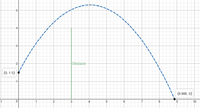Susan Smith
New member
- Joined
- Sep 14, 2019
- Messages
- 20
it going to beIn the first part of the last question, we are simply being asked to find the \(x\)-intercepts. To do so, we let \(y=0\):
[MATH]-0.23x^2+1.87x+1.5=0[/MATH]
And then solve for \(x\). I'd begin by multiplying through by -100, so clear the decimals and get rid of the leading negative sign:
[MATH]23x^2-187x-150=0[/MATH]
Next, apply the quadratic formula...what do you get?
X= 187+-radical48769/46
is that right?

